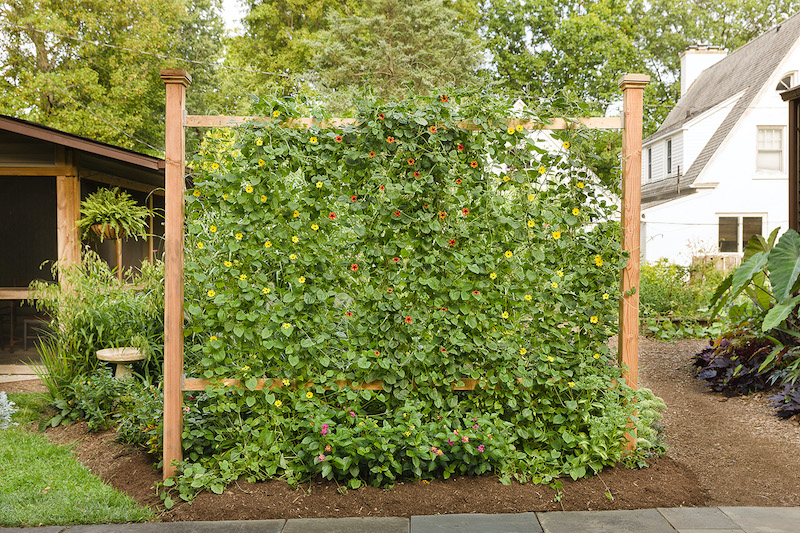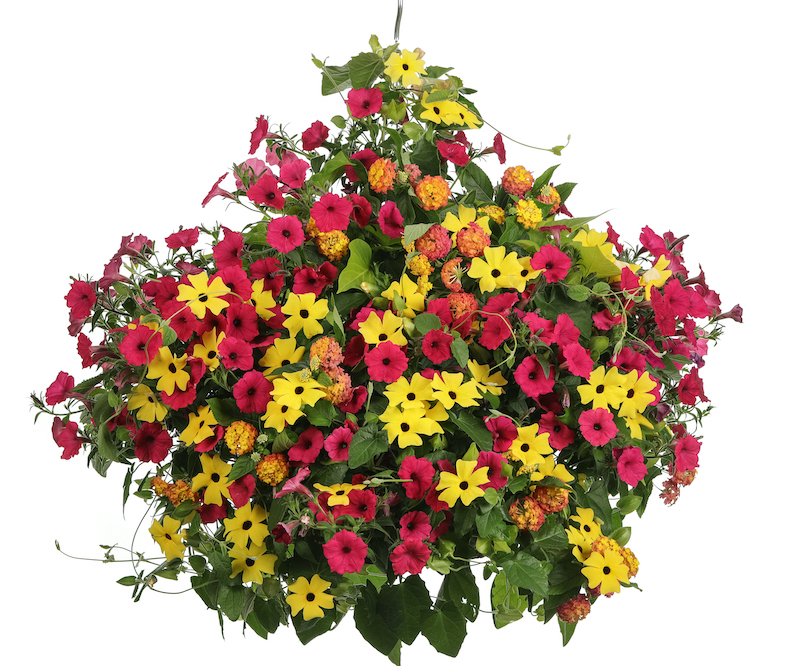Growing Black-Eyed Susan Vine
Black-Eyed Susan vine, which is also known commonly as Clock Vine, is a tropical vine or groundcover, native to Eastern Africa. The scientific name is Thunbergia alata, and this plant has little in common with the prairie plant Black-Eyed Susan.
Thunbergia is sold in most parts of the United States as an annual that grows well in a container or even as part of a hanging basket. The flower colors include mostly hot colors and a white cultivar. Black-Eye Susan Vine loves full sun but will tolerate shade early or late in the day. Once the weather starts to turn cold in the fall, Black-Eyed Susan Vine can be brought into the house to be overwintered.

Planting Black-Eyed Susan Vine
Black-Eyed Susan Vine is typically available in nurseries from April through early summer. These annuals will need some kind of trellising or other support to grow up. The overall height can be as much as 8 feet by the end of the summer. These prolific vines will bloom heavily from May to the first frost and need to be planted in a pot they will not outgrow in one season.
Pots with at least a 12-inch diameter will be fine for planting one Black-Eyed Susan Vine. These plants also make for an interesting, short-lived groundcover in spots where other plants won’t grow well. When planted in the ground, they will need to be watered on a very consistent basis.

Watering Black-Eyed Susan Vine
These tropical vines do best with at least 1 inch of water a week. Make sure that the soil and/ or container housing Black-Eyed Susan Vine drains well. Waterlogged roots are the enemy of this plant. Mulching either the ground around the plant or the top of the container will help to conserve moisture and keep the roots cooler during the heat of the summer. During periods of extreme heat or drought, make sure to check containers on a daily basis for watering.
Fertilizing Black-Eyed Susan Vine
Black-Eyed Susan Vines are treated like annuals and will need continued fertilizing to keep them flowering and growing vigorously. Use a dilute liquid feed of fish emulsion or mixed seaweed once a month. Watering leaches the nutrients out of the potting soil, so plants growing in containers will need feeding every 2 weeks. Using a liquid fertilizer formulated for blooming and rooting (higher P and K numbers) will encourage prolific blooms and strong roots.
Pruning Black-Eyed Susan Vine
Deadheading is almost impossible with a vining plant like Thunbergia. Black-Eyed Susan Vine cultivars are almost all self-cleaning and won’t require manual deadheading to continue flowering. Keeping this vigorous grower to whatever size you choose is easy. Cut back side shoots and top growth if it gets out of hand. New growth will quickly appear with more flowering buds. Shorter days are what trigger this plant to start producing seeds instead of flowers.
Caring For Black-Eyed Susan Vine in Pots
Black-Eyed Susan Vine grows best in a container of some sort. A pot with at least a 12-inch diameter is fine if you grow just one plant. Combining this vine with other plants in a seasonal mixed planting is very effective. For combination plantings, the diameter of the pot needs to be 16 inches or greater to allow room for all of the plants to grow. All-purpose potting soil has the perfect consistency and drainage for Black-Eyed Susan Vine.
Fertilizing will need to be done approximately every 2 weeks with diluted liquid fertilizer. Make sure to water pots until water runs out of the drainage holes. This ensures that all of the soil is saturated.

Winter Care for Black-Eyed Susan Vine
Since Black-Eyed Susan Vine is treated like an annual, no winter maintenance is required other than disposal of any spent top growth during the winter clean-up. Seeds from the cultivars may be saved for sowing in the spring. Alternatively, this vine could be brought into the house and treated as a houseplant for the winter.
The light levels need to be high or use a grow light to support the foliage growth through the winter months. Black-Eyed Susan Vine may bloom at a much slower rate in the house. It really depends on the amount of direct sunlight they receive. Make sure to provide ample humidity and cut back a bit on watering during the winter. Make sure the top 2 inches of potting soil dry out in between waterings.
 |
Author Robbin Small - Published 7-31-2022 |
